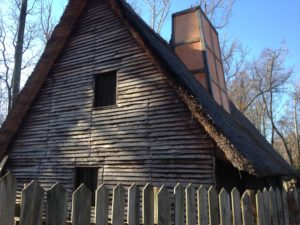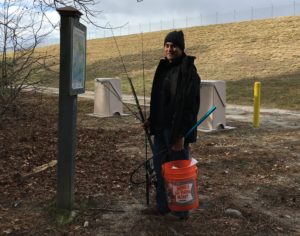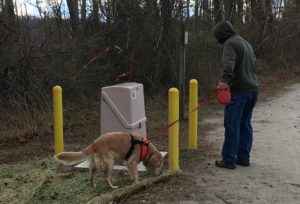Hello Fellow Readers, While visiting dear Mom in a nursing home in Virginia, we stumbled upon a historic place along the James River and took respite amongst nature. Entering Henricus Historical Park in Chester, VA is a remarkable Dominion Power plant powered by coal cohabitating amongst History & Nature. Dominion Energy is one of the country’s largest electric power and natural gas companies, serving 14 states. They pride themselves on responsible environmental stewardship.
Coal energy spearheaded the growth of our country.
 While the clouds billowing above the majestic pipes may cause concern, there’s something magnificent about it. Patriotic really as you consider the history of coal energy that spearheaded the Industrial Age and the growth of our country. The plant is neat and impressive and surrounded by railroads with vast lanes of open cargo coal cars.
While the clouds billowing above the majestic pipes may cause concern, there’s something magnificent about it. Patriotic really as you consider the history of coal energy that spearheaded the Industrial Age and the growth of our country. The plant is neat and impressive and surrounded by railroads with vast lanes of open cargo coal cars.
Then there’s the coal ash managed meticulously. A massive pile underneath a grassy cover three stories high is centered amongst a network of trails with boat launches, prolific fishing spots, and a bird sanctuary known as the Dutch Gap Conservation Area, proving there can be a balance between industry and nature.
I thought the trails were part of the Henricus Historical Park but learned it stands alone, yet the histories intertwined for thousands of years.

Rocke Hall, Henricus Historical Park, Chester, VA. Reverend Alexander Whitaker’s home provided a home for Pocahontas when she was brought to Henricus in 1613.
About the Dutch Gap Conservation Area
Native Americans resided in the area over 10,000 years ago. First, there were seasonal camps as they foraged and hunted. Then, as they developed techniques of raising crops, agriculture was born, and villages emerged. By the early 1600s, the Powhatan Chiefdom grew to be one of the most complex cultures in the area when the English settlement began.
In 1611 Sir Thomas Dale arrived in Virginia and established Henricus. He began altering the land using a Dutch method of digging a ditch to create a moat around the city for protection. The area on each side of the moat became known as Dale’s Dutch Gap.
As you would guess, the cohabitation between the settlers and the Native Americans did not go smoothly. You can visit the Henricus Historical Park website (link below) to learn the area’s vast history, including its significance during the Revolutionary and Civil Wars.
In the 1930s, they extended the Dutch Gap Canal to where the Dominion power plant is today. Coal remains a significant energy source for electricity generation because of its low cost and abundance compared to other fuels. They use scrubbers on emissions, and in the future, Dominion writes that coal gasifiers could be added to create a clean burnable gas from the coal.
It’s comforting to know power plants and wildlife can peacefully coexist. Garden Dilemmas? Askmarystone@gmail.com
Column updated 9/1/21
Henricus Historical Park website – www.henricus.org and Dutch Gap Conservation Area,
About the environment of Henricus Historical Park
“Have you ever fished here before?” I asked a young man as he studied the Dutch Gap Conservation map.
“No, ma’am, but there’s lots of fish here.”
When I returned home, I reached out to Mark Battista, Naturalist of the Dutch Gap Conservation Area, who shared, “amphibians are often the first evidence of the decline of an environment.”
The abundance of fish and birds is a great sign of a sound environment. I asked Mark about the newly installed boxes and learned they are wells installed by Dominion Energy to monitor groundwater.
“This process had been quite controversial,” wrote Mark Battista, ” since opponents were hoping Dominion Energy would remove and transfer the fly ash into modern and lined containment ponds. Because of their age, the current ponds are not lined, so there is concern that mercury, arsenic, and other waste will leach into the groundwater and river.”
He also added that Dominion often exceeds the rules of the EPA and DEQ (VA Department of Environmental Quality) and are contributors and partners in preserving the Dutch Gap.





